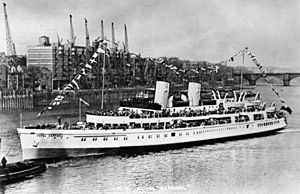MV Royal Daffodil (1939) facts for kids

Royal Daffodil in the Upper Pool, London
|
|
Quick facts for kids History |
|
|---|---|
| Name | MV Royal Daffodil |
| Owner | General Steam Navigation Co. Ltd. |
| Operator | General Steam Navigation Co. Ltd |
| Port of registry | London |
| Builder | William Denny and Sons, Dumbarton. |
| Yard number | 1330 |
| Launched | 24 January 1939 |
| Completed | May 1939 |
| In service | 1939 |
| Identification | |
| Fate | Scrapped 1967 |
| General characteristics | |
| Tonnage | 2,060 GRT |
| Length | 299 ft 7 in (91.31 m) |
| Beam | 50 ft 1 in (15.27 m) |
| Depth | 9 ft 9 in (2.97 m) |
| Propulsion | 2 x SCSA diesel engines (Wm Denny & Bros Ltd, Dumbarton) 841 hp (627 kW), Twin screws |
| Speed | 21 knots (39 km/h) |
| Capacity | 2,073 passengers |
The MV Royal Daffodil was a special ship built in 1939. She was a passenger ship that sailed for many years. In the 1950s and 1960s, she became famous for trips to France where people didn't need a passport. These trips were popular because rules about buying drinks were different at sea. The ship was eventually taken apart for scrap in 1967.
The Ship's Story
The Royal Daffodil was launched in 1939. She was the third ship to have this name. The first Daffodil was a ferry from Mersey built in 1906. She became important during World War I. She helped a lot in the Zeebrugge Raid in 1918. Because of her brave service, King George V gave her the special name Royal.
This first Royal Daffodil was sold in 1933. A new company, New Medway Steam Packet Co. Ltd, used her for trips. When this company was taken over in 1936, the old Royal Daffodil was sold for scrap. Her owners decided to build a bigger, new ship. They named this new ship Royal Daffodil as well. Meanwhile, another Royal Daffodil was built in 1934 for the Mersey. To avoid confusion, it was called Royal Daffodil II.
The Royal Daffodil we are talking about was built for trips to Europe. She started her service on April 28, 1939. Her first trip was to Calais, France. But soon after, World War II began in September 1939. The ship was quickly taken by the government for war duties.
Royal Daffodil in World War II
At first, the Royal Daffodil helped move people to safety. She evacuated about 4,000 women and children. They were moved from London and the Thames area to East Anglia. From September 15, 1939, she carried soldiers. These soldiers were part of the British Expeditionary Force (BEF). She took them from Southampton to Cherbourg, France. She continued this job until October 1939.
On May 21, 1940, the Royal Daffodil was ready for a big mission. She was on standby to help evacuate the BEF if needed. On May 23, she carried soldiers to Calais. She was one of the many ships that took part in Operation Dynamo. This was the famous evacuation of soldiers from Dunkirk in 1940. She saved 9,500 men in seven trips.
During one trip on June 2, 1940, a bomb hit her. The bomb went right through the ship and exploded underneath. This made a hole in her side. The captain quickly told everyone to move to the other side of the ship. This lifted the hole out of the water. They put a temporary patch of mattresses and wood over the hole. The Royal Daffodil made it safely to Ramsgate. All the rescued soldiers got off the ship there. Later, she sailed to Deptford for full repairs. Besides the bomb, the Royal Daffodil also survived attacks from machine guns and torpedoes.
For the rest of the war, the Royal Daffodil carried military people. She sailed between Stranraer and Larne. Even after the war ended in 1945, the government kept her. She helped with military travel between Dover and Calais, and between Newhaven and Dieppe. She did this until January 1947. During the war, she carried almost 2,444,000 service members. She traveled about 170,000 nautical miles.
After the War: Fun Trips and Music
After the war, the Royal Daffodil was fixed up by her builders. She then started new trips for fun. She sailed from Gravesend or Tilbury to see the French coast. She also stopped at Southend and Margate. From 1954, passengers could land in France again. At first, they needed passports. But from 1955, they could go without passports.
A person named Paul Lincoln used the Daffodil for live music. From 1957 to 1963, bands played Rock and Skiffle music on board. Famous performers like Gene Vincent in 1962 and Jerry Lee Lewis in 1963 played on the ship. In 1960, a company hired the ship for a staff celebration. They sailed downriver to Margate. Sadly, the music trips didn't make enough money. In 1966, the Royal Daffodil made her very last trip across the sea.
She was sold to be scrapped in Ghent, Belgium, in 1967. She made her final journey to the scrapyard by herself. This event was even shown on BBC TV.

